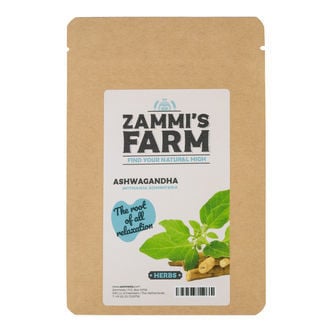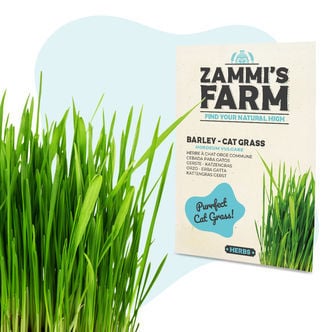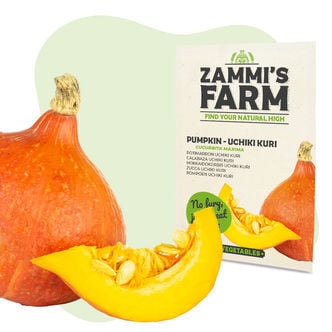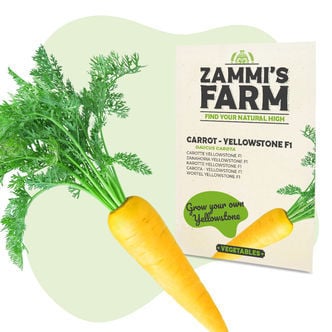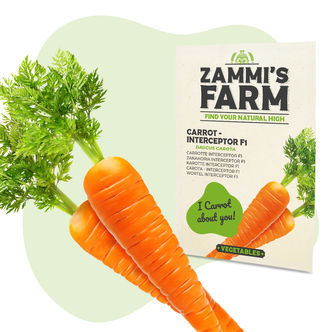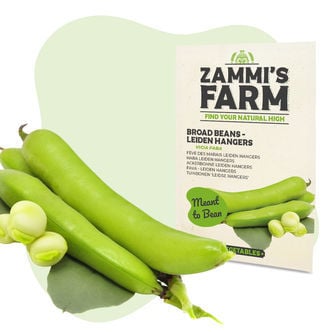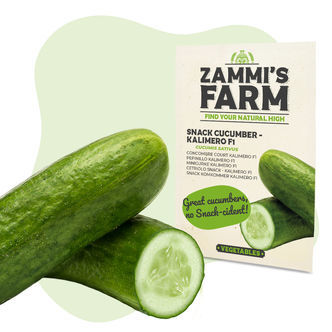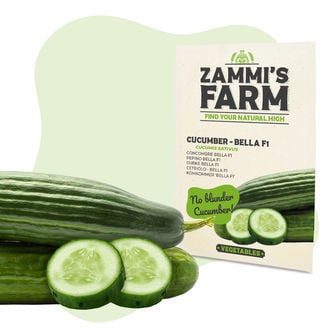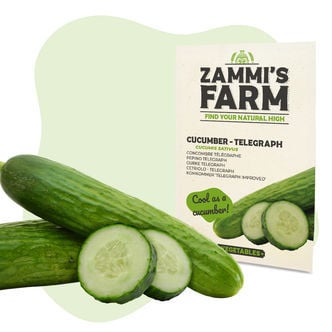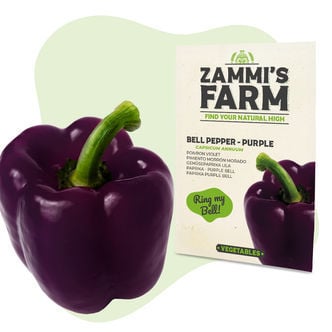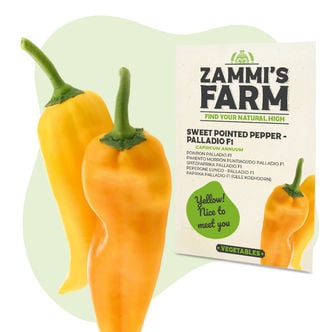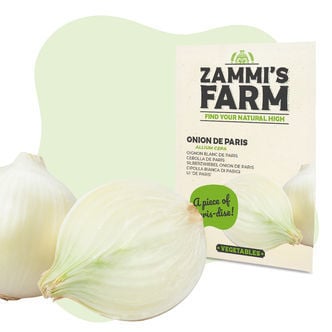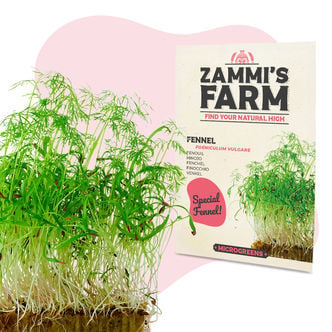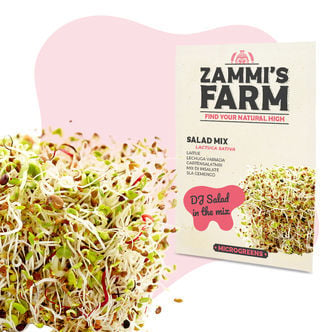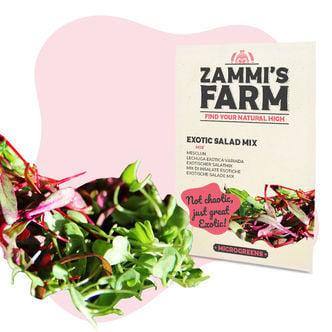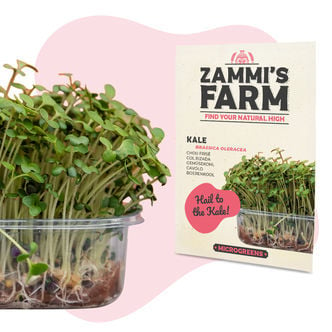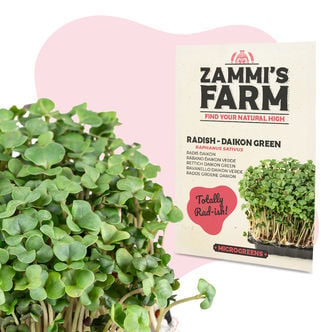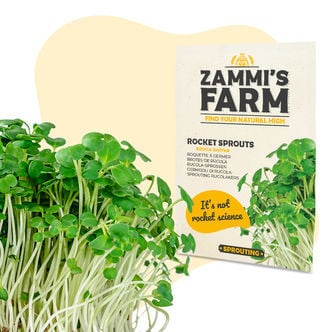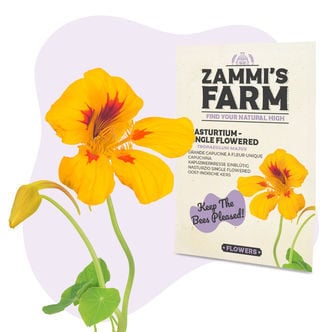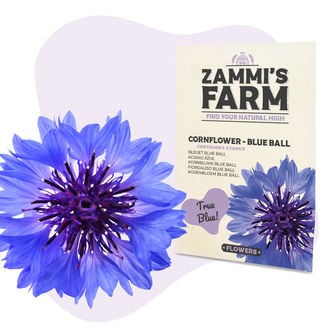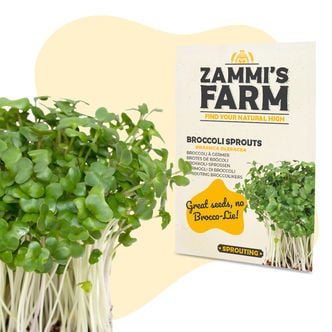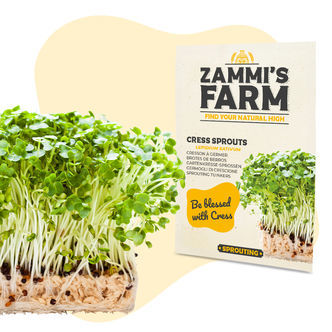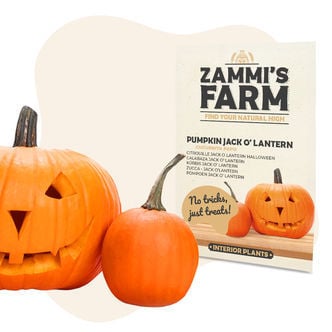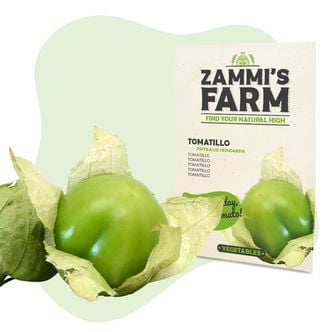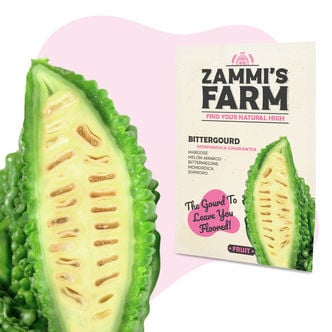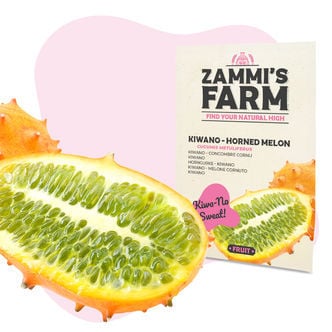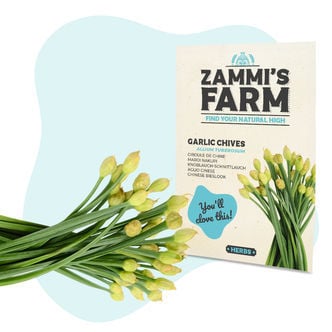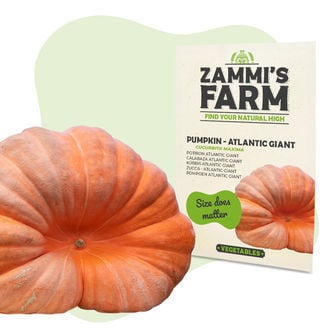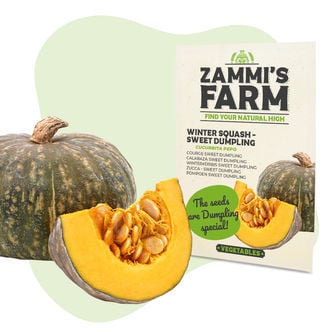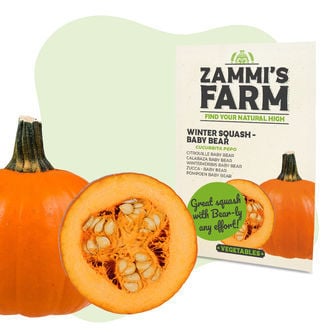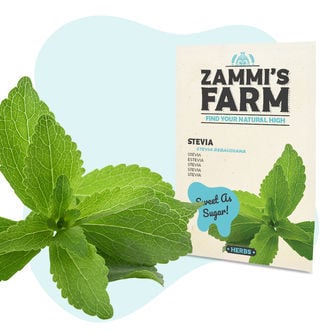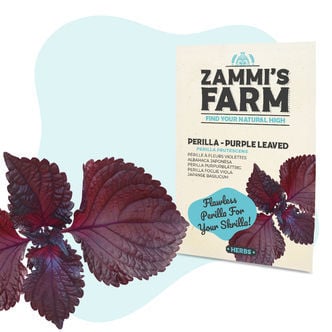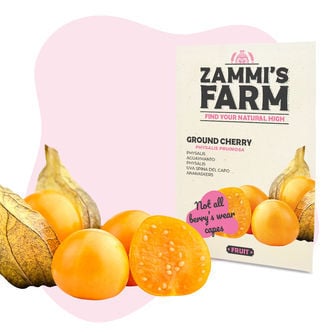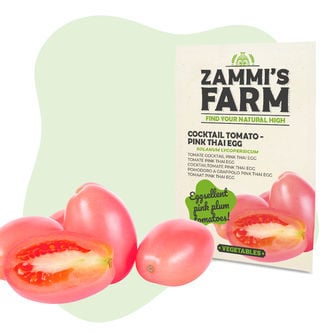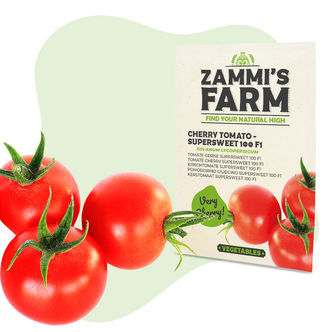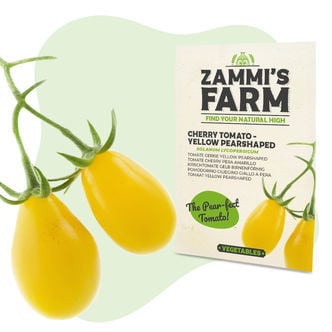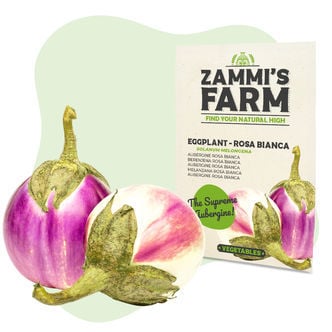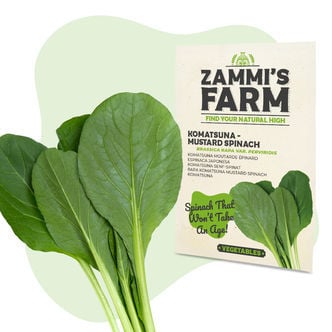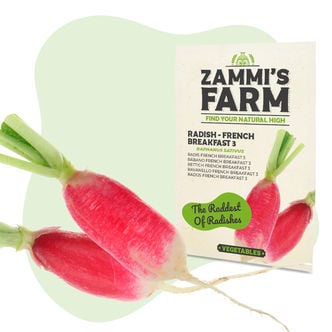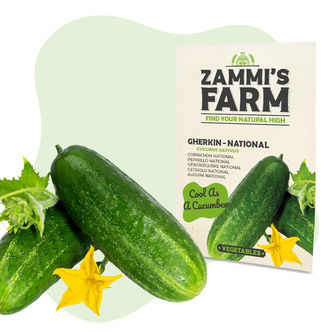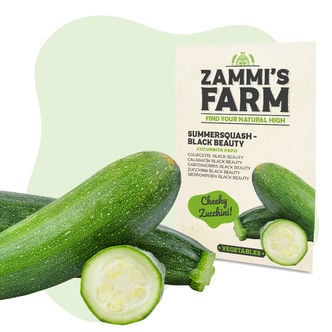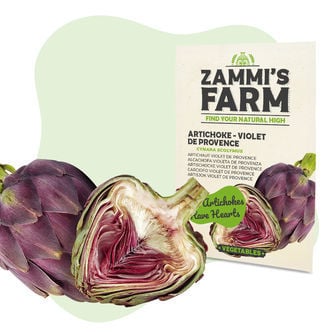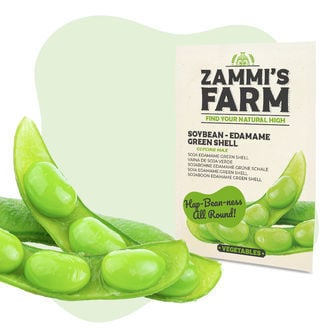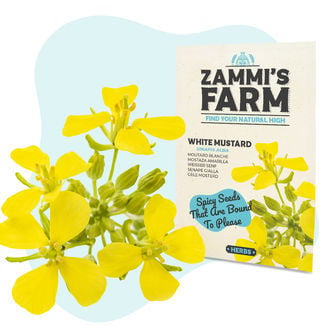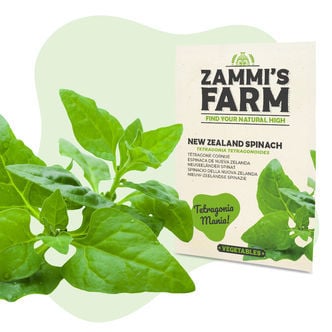Edible Plant Seeds
There are 116 products.From fruits and vegetables to herbs and spices—there's no shortage of edible plants you can grow at home. At Zamnesia, we now stock a wide variety of edible plant seeds for hobby gardeners and food farmers. From everyday favourites like Alpine Strawberries to unique cultivars like Dark Opal Basil and Lemon Apple Cucumbers, we consistently stock exciting edible plant varieties for your garden. Browse our selection below, and remember; Zamnesia edible plant seeds are specially selected for quality and maximum germination rates.
Ashwagandha (Withania somnifera) Seeds
Ashwagandha (Withania somnifera) is a shrub native to India, and it has been used for many years in the Ayurvedic tradition. Attractive and easy to cultivate, why not try growing it in your very own garden?
Barley - Cat Grass (Hordeum vulgare) Seeds
Barley - Cat Grass (Hordeum vulgare) Seeds are, as the name suggests, purrfect for your cat. It works as a digestive aid for them and may also prevent hairballs! The plant is effortless to grow and care for and can be sown between the months of April and September. Pick a light spot for them to flourish in, but ensure it doesn't get too much direct sunlight. This is one fast plant to grow!
Pumpkin Uchiki Kuri (Cucurbita maxima) Seeds
Uchiki Kuri, also known as Red Kuri, is a bright orange squash variety. Seeds can be sown in spring outdoors directly in seed beds. Mature plants like rich organic soil, so prepare the soil with compost or manure or fertilize regularly. Besides being very decorative, Uchiki Kuri squash boasts sweet flesh that goes great in sweet and savoury recipes.
Yellowstone F1 Carrot (Daucus carota) Seeds
Add some bright yellow magic to your garden with these Yellowstone F1 Carrot (Daucus carota) Seeds. Simply sow these seeds directly into the ground in March and keep the soil moist throughout their growing cycle. When August rolls around, you'll be met with a whole bunch of yellow carrots that are perfect for a wide variety of dishes and meals. What could be better than that?
Carrot - Interceptor F1 (Daucus carota) Seeds
These slimline carrots make for a healthy snack and have a sweet, satisfying taste. What's more, is that these seeds are effortless to cultivate and are unlikely to give even the most novice of growers a hard time. Sow these seeds directly into the ground and provide them with a little maintenance and upkeep and they'll deliver a bevvy of bright orange beauties come July-October. Perfect.
Broad Bean Leidse Hangers (Vicia faba) Seeds
Broad beans are not only delicious but also super healthy. This fast-growing and resistant variety can be planted in early spring or fall and produce plentiful harvests of long, sweet beans filled with 5-6 pods. Blanched, stir-fried, or in soups and stews, these delicious beans make a great addition to a variety of meals. Plus, they can also be frozen fresh and keep for months in the freezer.
Kalimero F1 Snack Cucumber (Cucumis sativus) Seeds
Whether pickled, as part of a salad or just a healthy treat, our Kalimero F1 Snack Cucumber is an incredibly simple veg to cultivate, not to mention extremely fast too! Get them going indoors around March and bring them outside for them to flourish over Summer. They're so quick to grow that you can actually get a few harvests from the same plant at the end of Summer. Versatile and accessible!
Cucumber Bella F1 (Cucumis sativus) Seeds
Bella F1 cucumber seeds (Cucumis sativus) produce long, sweet, and crisp fruit and are resistant to mildew. Start seeds outdoors in early-mid Spring and remember to water your plants generously while taking care not to wet their leaves (which attracts moulds and other pathogens). Use trellises to support the long vines and save space, and enjoy continuous harvest all throughout summer.
Telegraph Cucumber (Cucumis sativus) Seeds
There's nothing quite like the refreshing flavours of cucumbers. Whether added to salads or as a snack, Telegraph Cucumber (Cucumis sativus) is one versatile veg. Get these seeds started under glass from mid-March, provide some maintenance and upkeep, and come Summer, you'll have plenty of cucumbers to get your fill of. Leave around 40cm between plants and provide moist soil, and you're golden.
Paprika Purple Bell (Capsicum annuum) Seeds
Add some vibrant violet colours to your garden! Paprika Purple Bell is the way to go. Get these seeds sown and started under glass between March and May, and you'll be greeted with a bevvy of purple peppers come summertime. Just house them in moist soil with a consistent temperature of around 20-25°C; you can't go wrong. With sweet flavours, they make the perfect addition to all kinds of dishes.
Sweet Pointed Pepper Palladio F1 (Capsicum annuum) Seeds
Get these bright yellow beauties going from mid-March, and give them plenty of light, sun and moist soil, and they'll flawlessly perform. These sweet and mild peppers will be ready come late Summer. They require very little in the way of maintenance and are extremely versatile. Whether you add them to salad, tacos or any other savoury dish, these yellow peppers are sure to brighten your plate.
Sweet Pointed Pepper Kapiya (Capsicum annuum) Seeds
Looking for something genuinely vibrant both in colour and flavour? Allow us to introduce the Sweet Pointed Pepper Kapiya. It's believed this pepper is originally from Bulgaria but has been used widely throughout Europe and the rest of the world. Sow these seeds in early Spring and repot as soon as the first leaves appear. Move the plants outside and let them flourish until October.
Onion de Paris (Allium cepa) Seeds
How do you get your hands on some great-tasting onions? Easy, simply sow these seeds in early Spring under glass and then move them outside in late April. This will give them plenty of time over the summer to mature and be ready for the picking! These onions are perfect for pickling or including as tiny veg on your plate or as part of a summer salad. The options are plentiful, and so is the yield!
Microgreens Fennel (Foeniculum vulgare) Seeds
Peppery, mild and sweet, Microgreens Fennel takes just 7-14 days to germinate and just another 2 weeks on top until the earliest greens are ready to harvest and use in a multitude of dishes. Just provide them with plenty of light and warmth and keep the surrounding soil moist, and you simply can't go wrong! This is one fast-to-grow plant that delivers in all areas. Get some in your home today!
Microgreens Salad Mix (Lactuca sativa) Seeds
With a selection of great greens available here, the vibrant Microgreens Salad Mix is ideal for adding to salads and can actually be grown all year round. Quick to flourish, sow the seeds when it works for you; just be sure to keep the soil moist but not waterlogged, and this plant will deliver delicious, moreish leaves and work perfectly in plenty of dishes. Ideal for all growers!
Microgreens Exotic Salad Mix - Seeds
Take your salad game to the new level with Exotic Salad Mix. It's really easy, just scatter the seeds on top of the soil and press gently. Cover with a thin layer of soil and spray with water. Use the mister once or twice a day to keep soil most. Harvest after 2–3 weeks, when you see the first set of true leaves. Microgreens thrive in sunny environments, think windowsills or balconies.
Microgreens Kale (Brassica oleracea) Seeds
Kale (Brassica oleracea) is in the spotlight for being one of the most nutritious greens on the market. But did you know that kale sprouts are even more packed with nutrients than fully mature kale plants? Sow kale seeds in a propagator at high density, and harvest your sprouts after 7–10 days for a fresh, delicious, and highly nutritious microgreen.
Microgreens Radish - Daikon Green (Raphanus sativus) Seeds
Green Daikon Radish is delicious and highly nutritious, used typically as a garnish in Japanese cuisine. Daikon Green Microgreens, however, are just as packed with flavor yet with much higher nutrient density. To grow them, simply sow seeds at a high density in a propagator and harvest the sprouts after roughly 1 week. With a fresh, tangy flavour, they go great in fresh and cooked Asian dishes.
Rocket Sprouts (Eruca sativa) Seeds
The peppery leaves of Rocket Sprouts make for the ideal addition to a wide variety of dishes; what's more, is that the path to this tasty produce is an extremely easy one, regardless of your prior expertise! Rocket Sprouts can be grown in indoor, outside, and greenhouse settings and require very little in the way of maintenance. Sow seeds in early Spring and enjoy great flavours come Summer.
Nasturtium 'Single Flowered' (Tropaeolum majus) Seeds
Boasting deep red, orange, and yellow hues, nasturtium flowers are surrounded by rich green leaves, making for a visually appealing plant. Able to reach heights of around 3m, this climbing plant is ideal for walled gardens and spacious areas. Not only boasting great looks, the flowers are also edible, making a vibrant addition to various dishes.
Cornflower 'Blue Ball' (Centaurea cyanus) Seeds
The Blue Ball cornflower is a great-looking flower that's ideal for a whole host of gardening set-ups. Sow the seeds directly into the ground in a place of your choosing in late spring, and they'll mostly take care of themselves throughout the summer. Without much needed in the way of maintenance, these flowers undoubtedly appeal to all levels of expertise. Colourful and vibrant, perfect for all.
Broccoli Sprouts (Brassica oleracea) Seeds
Whether you like them in your smoothie, salad or sandwich, there's no denying the rich antioxidants and tasty flavours of Broccoli Sprouts. They're also incredibly simple to cultivate. Sow the seeds in a pot in early Spring and give them plenty of sun, warmth and a little water now and again, and they'll flourish effortlessly. Come August, they'll be ready to harvest and can be enjoyed instantly.
Cress Sprouts (Lepidium sativum) Seeds
Cress Sprouts make for an easygoing and hugely rewarding growing project. Whether situated on a windowsill or as part of your garden, it'll perform with very little maintenance required. This is a fast-growing plant that can be sown and grown all year round. Just be sure to provide temperatures of around 20-22°C and a little upkeep, and you can enjoy tasty cress rich in vitamins A, B and C.
Cornflower 'Mixed' (Centaurea cyanus) Seeds
With an abundance of purple, blue, pink, and white hues, the cornflower (Centaurea cyanus) is one of the best options for brightening up your garden. Pleasing to the eye but overall undemanding, these plants will appeal to gardeners of all skill levels. Whether planted in borders or as wildflowers, these flowers will attract bees and other beneficial insects to your garden.
Pumpkin Jack O' Lantern (Cucurbita pepo) Seeds
Bred especially to be carved into Jack O' Lanterns, this beautiful orange, oblong Cucurbita pepo variety produces pumpkins that are very decorative yet still tasty, too. Sow your Jack O' Lantern seeds indoors in late winter, or directly outside in early spring. Like other pumpkin varieties, Jack O' Lanterns are best grown in fertile soil with stakes or trellises to accommodate their long vines.
Tomatillo (Physalis ixocarpa) Seeds
The Tomatillo or Mexican Husk Tomato dates back to the pre-Columbian era. It produces a spherical fruit with a green/purplish colour that looks similar to tomatoes but has a different flavour and texture. Tomatillo seeds are best sown indoors, and plants can be brought outside in Spring after the last frost. Tomatillo plants like well-draining soil, full sun, and regular organic fertilisation.
Bitter Gourd (Momordica charantia) Seeds
The bitter gourd, otherwise known as bitter melon or balsam pear, is a fruit that originally comes from Africa and Asia. However, now you can grow it right at home! Start it off in a greenhouse or indoors for 4 weeks, then move it outdoors to flourish in the summer months. Typically, it'll be ready to harvest come October. Pair it with fish or meat, and you simply can't go wrong.
Horned Melon (Cucumis metuliferus) Seeds
Looks can be deceiving with this prickly fruit. It might look a little intimidating, but it's what's inside that counts. The Kiwano houses a sweet taste that's reminiscent of lemons and bananas. Perfect for fruit salads and desserts. Start your plants out in a greenhouse and then place them outside for full sun. A little hands-on grow-wise but manageable, it needs a warm climate or location.
Garlic Chives (Allium tuberosum) Seeds
Also referred to as Chinese chives and oriental garlic, garlic chives are a tasty herb with flavours reminiscent of its namesake. It's used in a wide variety of dishes, such as fish, salads, and soups. Before using them, though, you'll need to grow them! An easy affair, you can grow garlic chives both indoors and outdoors. Just give them moist soil and regular light, and watch them thrive.
Atlantic Giant Pumpkin (Cucurbita maxima) Seeds
Try your hand at growing Atlantic Giant Pumpkin which can weigh 100kg and more. This vegetable thrives in warm and sunny spots, and you can sow your seeds indoors in mid-spring or early summer outdoors. Ensure your plants have fertile soil and are sheltered from cold winds and you will be able to sit back and watch this vigorous grower. Harvest in September/October, right for Halloween!
Winter Squash Sweet Dumpling (Cucurbita pepo) Seeds
Sweet Dumpling is a delicious variety of winter squash (Cucurbita pepo) with a hard, cream-coloured rind and tender, sweet flesh. Growing to roughly the size of a grapefruit, Sweet Dumpling squash make a great addition to any veggie patch. Start seedlings off indoor in late winter or directly outdoors in early spring. Like other squashes, plant Sweet Dumpling squash in highly fertile soil.
Winter Squash Baby Bear (Cucurbita maxima) Seeds
Baby Bear Winter Squash (Cucurbita maxima) is a must-have for every veggie patch. Germinate your seeds indoors and bring them outside in the spring. Plant Baby Bear squash in soil with plenty of manure or compost to ensure healthy growth and the production of large, sweet fruit. Use tutors, stakes, or trellises to grow Baby Bear Squash vertically in smaller spaces.
Stevia (Stevia rebaudiana) Seeds
Stevia rebaudiana or sugarleaf is very easy to grow. Germinate seeds indoors and bring them outside in mid-summer. Plant stevia in full sun in well-draining soil with a pH of 6.7-7.2. Feed plants regularly with a natural liquid fertilizer or nitrogen-rich organic fertilizers like compost, worm castings, guano, or something similar to fuel healthy leaf growth. Use stevia as a natural sweetener.
Purple Perilla (Perilla frutescens) Seeds
Perilla, shiso, or deulkkae (Perilla frutescens) is an annual plant native to Southeast Asia and India, and is often used as a garnish for fish, rice, and tempura dishes. Perilla likes sunny or part-shade locations and deep, wide, well-draining plots of soil to accommodate its low, outward growth. Harvest mature perilla leaves and use them as an aromatic in your favorite dishes or infusions.
Ground Cherry (Physalis peruviana) Seeds
Also known as the Cape gooseberry, Ph. peruviana is native to Chile and Peru, where it is commonly called aguaymanto, uvilla, or uchuva. A member of the Nightshade family, the Ground Cherry produces sweet fruits in a papery husk. Propagate these seeds indoors in early spring, then bring plants outside in early summer. Their fruit is ripe once it falls from the plant and can be eaten raw.
Cocktail Tomato 'Thai Pink Egg' (Solanum lycopersicum) Seeds
Thai Pink Egg Tomatoes originate from Thailand where they're treasured for their bright colour and deliciously sweet flesh. While they grow very similarly to other tomato (Solanum lycopersicum) varieties, Thai Pink Egg tomatoes like a little more water than usual, and hold up better in rainy climates as well as heat waves. Remember to prune and fertilize tomatoes regularly for bountiful harvests.
Cherry Tomato 'Supersweet 100 F1' (Solanum lycopersicum) Seeds
The Supersweet 100 cherry tomato hybrid is one of those plant hybrids that says it all in its name: these plants produce extremely sweet fruit and, in the right conditions, can grow into long vines capable of producing 100 or more tomatoes at once. Note that this is a tall tomato variety that needs full sun, support from stakes/trellises, plenty of care, and a lot of natural fertilizer to thrive.
Yellow Pear Cherry Tomato (Solanum lycopersicum) Seeds
Besides their vibrant yellow colour, Yellow Pear Cherry Tomatoes (Solanum lycopersicum) boast a deliciously sweet, slightly acidic flavour. Sow your seeds in spring after the last frost and enjoy an endless supply of sweet cherry tomatoes all through summer. Yellow Pear tomatoes grow best in full sun and fertile soil. Fertilise plants regularly and use stakes or trellises to support their vines.
Eggplant 'Rosa Bianca' (Solanum melongena) Seeds
The Rosa Bianca eggplant variety (Solanum melongena) produces large, globe-shaped white fruit with beautiful lavender-purple streaks. Like other eggplant varieties, Rosa Bianca grows best in warm conditions and full sun. It likes fertile, moist, and acidic soil, occasional watering, and a hearty dose of phosphorus during flowering. Remember to mist plants regularly as soon as flowers appear.
Komatsuna (Brassica rapa var. perviridis) Seeds
Komatsuna is a unique variety of Mustard Spinach (Brassica rapa), also known as Japanese Mustard Spinach. Like other spinach varieties and leafy greens, Komatsuna seeds are best sown outdoors in nitrogen-rich, moisture-retentive soil. Mulching is recommended to help the soil retain more moisture. Seeds can be sown from early spring to autumn. Harvested leaves can be eaten fresh or cooked.
Cherry Tomato - Cerise (Lycopersicon esculentum) Seeds
Who doesn't love nice, fresh cherry tomatoes to enjoy? No matter the weather, you can have a bevy of bright-red beauties in next to no time. Sow seeds in early spring indoors or outside (if living in a warm climate), and they'll be ready come late summer. Give them moist soil and plenty of light and warmth, and you'll be rewarded with a great yield. Perfect for salads and all kinds of cooking.
Radish 'French Breakfast 3' (Raphanus sativus) Seeds
Crisp and crunchy are just words to describe the French Breakfast 3 variety of radish. They offer up a great "snap" when eaten and have a fresh flavour that's perfect for blending with other vegetables. In fact, it's even recommended that these seeds are sown next to carrots or lettuce to give them a good biological balance. Begin them in March, and they'll be good later in the summer.
Gherkin 'National' (Cucumis sativus) Seeds
Grow these gherkins in your garden and you'll have a fine selection of small fruits to pick from. Get them going in early April indoors or in a greenhouse, and then take them outside to plant in May. Provide them with shelter and sun, and you'll have a harvest of gherkins-goodness in no time. Perfect for pickling, they will add some flair and flavour to your food.
Summer Squash 'Black Beauty' (Cucurbita pepo) Seeds
Whether you know it as courgette or summer squash, this adaptable vegetable lends itself well to all kinds of cuisines. Able to produce a huge harvest, make the most of your plants by starting them under glass, and then move them outside to flourish in the summer months. Give them the perfect balance of sunlight, warmth, and shade, and you'll be rewarded with plenty of delicious veggies.
Artichoke 'Violet de Provence' (Cynara Scolymus) Seeds
Not only mindblowing in the flavour department, but Violet de Provence artichokes also showcase amazing looks that make it a must for any garden. Sow the seeds indoors between February and April, and place them outside in early summer. This is a perennial plant that will just keep going as long as you need it. Easy to care for, just cover in the winter months, and it'll usually look after itself.
Soybean 'Edamame Green Shell' (Glycine max) Seeds
Perfect in Asian cuisines and as a healthy snack, edamame has plenty of uses. You'll be pleased to know that it's also pretty easy to cultivate from home too! Get plants started indoors or in a greenhouse in early May, and then once the seedlings are big enough, move them outdoors to soak up the sunlight and warmth. Come October, you'll have a bevy of soybeans ready to go.
White Mustard (Sinapis alba) Seeds
White mustard (Sinapis alba) is versatile. Use the seeds in cooking, sauce making and pickling, and the young leaves in salads and other dishes. The choice is entirely up to you. If you're looking to grow, sow the seeds in March, and they'll be ready in the summer. Generally low maintenance, all it takes is just some moist soil and the standard light and warmth, and you'll be golden.
New Zealand Spinach (Tetragonia tetragonoides) Seeds
New Zealand spinach can be harvested over a long period, which makes it ideal for continual use in cooking once ready. Be sure to soak the seeds in a bowl of water overnight before sowing to make sure they germinate. Able to be sown inside in early April or plant outdoors in May-August. Provide warmth and sun and come November time, you'll be ready to enjoy all New Zealand spinach has to offer.















 United States
United States
